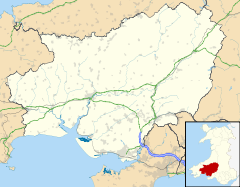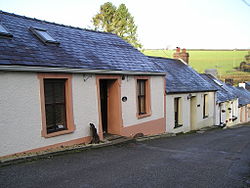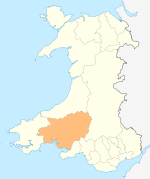- Dre-fach Felindre
-
Coordinates: 52°00′55″N 4°24′24″W / 52.015317°N 4.406548°W
Dre-fach Felindre
 Dre-fach Felindre shown within Carmarthenshire
Dre-fach Felindre shown within CarmarthenshirePopulation (2001) OS grid reference SN305405 Principal area Carmarthenshire Ceremonial county Dyfed Country Wales Sovereign state United Kingdom Post town LLANDYSUL Postcode district SA44 Dialling code 01559 Police Dyfed-Powys Fire Mid and West Wales Ambulance Welsh EU Parliament Wales UK Parliament Carmarthen East and Dinefwr Welsh Assembly Carmarthen East and Dinefwr List of places: UK • Wales • Carmarthenshire Dre-fach Felindre is a village in Carmarthenshire, West Wales. It is located four miles south-east of Newcastle Emlyn. It lies at the confluence of three fast-flowing streams, the Nant Bargod, Nant Esgair and Nant Brân, where their steep-sided valleys open out into the Teifi Valley. In the 19th and early 20th century it was an important centre for the woollen industry and was given the epithet, "the Huddersfield of Wales". As the population increased, the villages of Dre-fach (Welsh language, small town) and Velindre (Welsh language, mill town) extended and merged to form the present community.
The Museum of the Welsh Woollen Industry, now the National Woollen Museum, was opened in 1976 in the Cambrian Mill.
History
Little development happened in this area before the late 18th century and it is not clear why Dre-fach Felindre became such an important centre for the production of woollen cloth in Wales. By the early 19th century, four fulling mills were established at Pentrecwrt, Dolwyon, Drefach and Cwmpencraig. Spinning and weaving were done by hand or in small workshops at this time. In the 1850s, the power loom was introduced, the need for water power increased and there was a great expansion of the industry. Substantial mills, some employing 50-100 people, were built at Drefach, Felindre, Drefelin, Cwmpengraig, Cwmhiraeth and Pentre-cwrt by the first decade of the 20th century. The population increased in Drefach and Felindre and houses were built for mill workers and mill owners, shops opened and St Barnabas' Church and other places of worship were built. Overflow settlements occurred at Cwmpencraig and Cwmhiraeth, where more factories, mill owner houses, worker houses and chapels clustered in the narrow valleys. The woollen industry declined from the 1920s onwards and the mills closed one by one.[1]
At its peak, there were ten mills on Nant Bargod and twenty four in the whole village.[2] As the textile industry flourished, so did the social, cultural and religious institutions in the village. Because Dre-fach Felindre was reliant on industry rather than on agriculture like the surrounding countryside, the outlook of the inhabitants was different. It resembled that of the South Wales valleys with their billiard halls, brass bands, male voice choirs and soccer teams.[3]
The Unitarian chapel of Penrhiw was built in 1777. In 1952 it was dismantled stone by stone and rebuilt at St Fagans National History Museum. Services are still held in the chapel at its new location, and burials still take place at the cemetery at its original site on a grassy slope overlooking Felindre.[4]
Culture and community
Dre-fach Felindre has little industry today. The mills still stand as monuments to the past but have been put to other uses. One now houses the National Woollen Museum, another a furniture warehouse and others have been converted to residences or accommodation for holiday visitors. There is a post office, a few shops, a church, several chapels and a primary school, Ysgol Gynradd Penboyr. There is a community hall, the Red Dragon Hall, and a children's playground. The football club, Bargod Rangers, plays at the community park, Parc Puw.
The poet and broadcaster Aneirin Talfan Davies was born in the village. The musician and writer Rhiannon Cooper resides in the village.
References
- ^ Archaeology in Wales.
- ^ The Woollen Mills of Wales, leaflet from National Museum Wales.
- ^ Jenkins, J. Geraint. Ceredigion: Interpreting an Ancient County. Gwasg Careg Gwalch (2005) pg. 12.
- ^ Jones, Alun L. (editor), A Century of Photographs. (2000) pg. 76.
Categories:- Villages in Carmarthenshire
- Wales geography stubs
Wikimedia Foundation. 2010.



